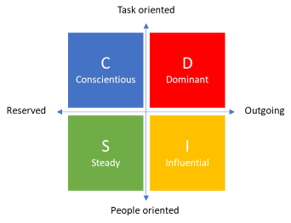If you are new to the idea of Team Praxis, please read our introduction to the concept before using the table below to improve your communications with team members, stakeholders and anyone else involved in your project, programme or portfolio.
 The goals of resource management are to:
The goals of resource management are to:
- determine the best way to resource the work;
- acquire and mobilise the necessary resources;
- control resources throughout the life cycle;
- demobilise resources at the end of the life cycle;
- finalise all contractual arrangements.
When implementing these goals people with different character traits would perceive resource management plans and techniques in different ways.
 Concientious behaviour would typically propose or want to see: Concientious behaviour would typically propose or want to see:
-
an evidenced based and structured approach to assessing options and formalising the approach to resourcing the work; -
an early and planned approach to mobilising resources including ensuring they have the necessary information; -
contingency plans for resource mobilisation to deal with any risks identified during the planning; -
comprehensive and detailed control of the resources throughout the life cycle including regular monitoring and reporting; -
a planned and orderly approach to demobilising resources at the end of the life cycle. Someone exhibiting concientious behaviour would typically be perceived as: -
formal and treating all forms of resource in a similar manner; -
someone who sticks to the agreed resourcing processes; -
wishing to see validated information being used during the process and before making a decision; -
cautious and therefore requiring ample time for mobilising resources. |  Dominant behaviour would typically propose or want to see: Dominant behaviour would typically propose or want to see:
-
an early decision made on the most effective option for resourcing to aid early delivery; -
an efficient means of mobilising people ensuring they are clear on what needs to be delivered and by when; -
high-level control of resources, by exception reporting and quick decision making; -
demobilisation of resources as quickly as possible to ensure the focus remains on future deadlines; - formal and quick closure of contractual arrangements ensuring each party has agreed to any ongoing commitments.
Someone exhibiting dominant behaviour would typically be perceived as: -
innovative and wishing to see people involved in identifying options; -
informal and often working around the processes where seen as constraining; -
fast paced and wishing to see resources starting quickly without being overly burdened by process making decisions based on gut feel and later backing up with data. |
 Steady behaviour would typically propose or want to see: Steady behaviour would typically propose or want to see:
-
stakeholders involved in agreeing how the work will be resourced; the early engagement with people as they mobilise, including induction and clarification of their role; control of the resources through continued engagement and communication to identify any changes to the agreed plan; a personal and planned approach to demobilising resources including support in finding or transitioning to a new role; a planned approach to the closure of contractual arrangements and change in relationships including the identification of remaining risks. Someone exhibiting steady behaviour would typically be perceived as: -
treating people differently from other resources due to their empathic nature; -
being cautious therefore wishing for risks and issues to be discussed and dealt with quickly and openly; -
indecisive when decisions need to be made in particular when there is uncertainty or time pressures. |  Influential behaviour would typically propose or want to see: Influential behaviour would typically propose or want to see:
-
consideration of multiple options and then a group decision as to the agreed approach to resourcing; -
people having a broad understanding of the context and dynamics of the relationships between all parties; -
a light touch form of control of the resources with open and group discussions regarding any current or future challenges; -
that as people are demobilised, the value they have added is communicated; - an open discussion during the closure of contractual arrangements to ensure there is a common understanding of any ongoing relationship.
Someone exhibiting influential behaviour would typically be perceived as: -
innovative and wishing to see people involved in identifying options; -
informal and often working around the processes where seen as constraining; -
fast paced and wishing to see resources starting quickly without being overly burdened by process; -
making decisions based on gut feel and later backing up with data. |
Thanks to Donnie MacNicol of Team Animation for providing this page.
 The goals of resource management are to:
The goals of resource management are to:
 Concientious behaviour would typically propose or want to see:
Concientious behaviour would typically propose or want to see: Dominant behaviour would typically propose or want to see:
Dominant behaviour would typically propose or want to see: Steady behaviour would typically propose or want to see:
Steady behaviour would typically propose or want to see: Influential behaviour would typically propose or want to see:
Influential behaviour would typically propose or want to see:



